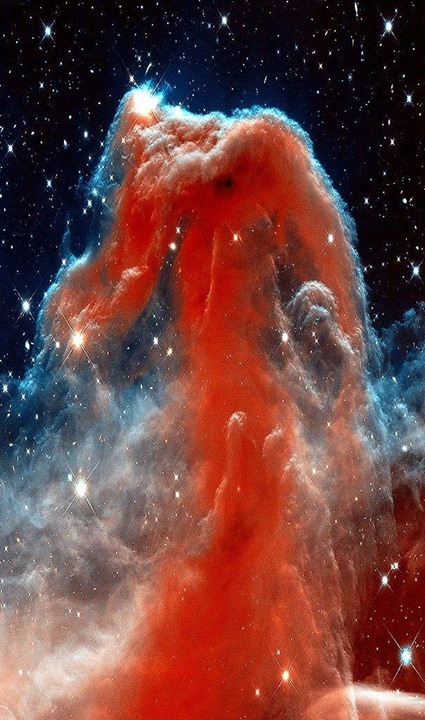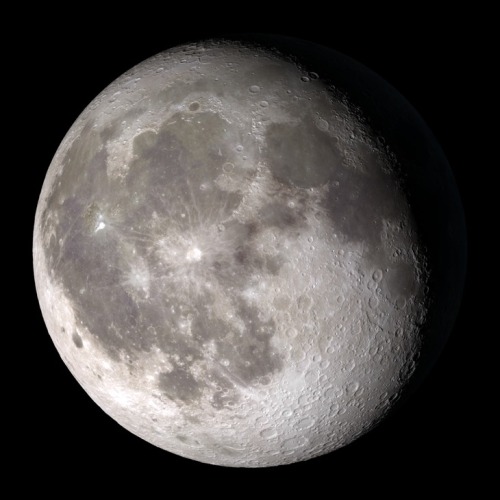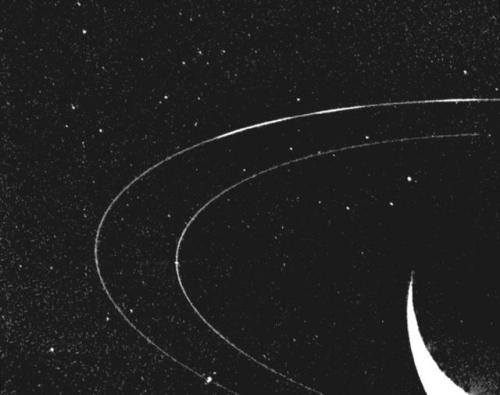Starsglaxiesspace - SPACE

More Posts from Starsglaxiesspace and Others




(NASA) Unexpected X-Rays from Perseus Galaxy Cluster
Image Credit: X-ray: NASA/CXO/Oxford University/J. Conlon et al.; Radio: NRAO/AUI/NSF/Univ. of Montreal/Gendron-Marsolais et al.; Optical: NASA/ESA/IoA/A. Fabian et al.; DSS
Why does the Perseus galaxy cluster shine so strangely in one specific color of X-rays? No one is sure, but a much-debated hypothesis holds that these X-rays are a clue to the long-sought identity of dark matter. At the center of this mystery is a 3.5 Kilo-electronvolt (KeV) X-ray color that appears to glow excessively only when regions well outside the cluster center are observed, whereas the area directly surrounding a likely central supermassive black hole is actually deficient in 3.5 KeV X-rays. One proposed resolution – quite controversial – is that something never seen before might be present: florescent dark matter (FDM). This form of particle dark matter might be able to absorb 3.5 KeV X-radiation. If operating, FDM, after absorption, might later emit these X-rays from all over the cluster, creating an emission line. However, when seen superposed in front of the central region surrounding the black hole, FDM’s absorption would be more prominent, creating an absorption line. Pictured, a composite image of the Perseus galaxy cluster shows visible and radio light in red, and X-ray light from the Earth-orbiting Chandra Observatory in blue.
Source

Comet Jacques In Between The Heart & Soul Nebulae


The Moon in Motion
Happy New Year! And happy supermoon! Tonight, the Moon will appear extra big and bright to welcome us into 2018 – about 6% bigger and 14% brighter than the average full Moon. And how do we know that? Well, each fall, our science visualizer Ernie Wright uses data from the Lunar Reconnaissance Orbiter (LRO) to render over a quarter of a million images of the Moon. He combines these images into an interactive visualization, Moon Phase and Libration, which depicts the Moon at every day and hour for the coming year.

Want to see what the Moon will look like on your birthday this year? Just put in the date, and even the hour (in Universal Time) you were born to see your birthday Moon.
Our Moon is quite dynamic. In addition to Moon phases, our Moon appears to get bigger and smaller throughout the year, and it wobbles! Or at least it looks that way to us on Earth. This wobbling is called libration, from the Latin for ‘balance scale’ (libra). Wright relies on LRO maps of the Moon and NASA orbit calculations to create the most accurate depiction of the 6 ways our Moon moves from our perspective.
1. Phases

The Moon phases we see on Earth are caused by the changing positions of the Earth and Moon relative to the Sun. The Sun always illuminates half of the Moon, but we see changing shapes as the Moon revolves around the Earth. Wright uses a software library called SPICE to calculate the position and orientation of the Moon and Earth at every moment of the year. With his visualization, you can input any day and time of the year and see what the Moon will look like!
2. Shape of the Moon

Check out that crater detail! The Moon is not a smooth sphere. It’s covered in mountains and valleys and thanks to LRO, we know the shape of the Moon better than any other celestial body in the universe. To get the most accurate depiction possible of where the sunlight falls on the lunar surface throughout the month, Wright uses the same graphics software used by Hollywood design studios, including Pixar, and a method called ‘raytracing’ to calculate the intricate patterns of light and shadow on the Moon’s surface, and he checks the accuracy of his renders against photographs of the Moon he takes through his own telescope.

3. Apparent Size

The Moon Phase and Libration visualization shows you the apparent size of the Moon. The Moon’s orbit is elliptical, instead of circular - so sometimes it is closer to the Earth and sometimes it is farther. You’ve probably heard the term “supermoon.” This describes a full Moon at or near perigee (the point when the Moon is closest to the Earth in its orbit). A supermoon can appear up to 14% bigger and brighter than a full Moon at apogee (the point when the Moon is farthest from the Earth in its orbit).
Our supermoon tonight is a full Moon very close to perigee, and will appear to be about 14% bigger than the July 27 full Moon, the smallest full Moon of 2018, occurring at apogee. Input those dates into the Moon Phase and Libration visualization to see this difference in apparent size!
4. East-West Libration
Over a month, the Moon appears to nod, twist, and roll. The east-west motion, called ‘libration in longitude’, is another effect of the Moon’s elliptical orbital path. As the Moon travels around the Earth, it goes faster or slower, depending on how close it is to the Earth. When the Moon gets close to the Earth, it speeds up thanks to an additional pull from Earth’s gravity. Then it slows down, when it’s farther from the Earth. While this speed in orbital motion changes, the rotational speed of the Moon stays constant.
This means that when the Moon moves faster around the Earth, the Moon itself doesn’t rotate quite enough to keep the same exact side facing us and we get to see a little more of the eastern side of the Moon. When the Moon moves more slowly around the Earth, its rotation gets a little ahead, and we see a bit more of its western side.
5. North-South Libration

The Moon also appears to nod, as if it were saying “yes,” a motion called ‘libration in latitude’. This is caused by the 5 degree tilt of the Moon’s orbit around the Earth. Sometimes the Moon is above the Earth’s northern hemisphere and sometimes it’s below the Earth’s southern hemisphere, and this lets us occasionally see slightly more of the northern or southern hemispheres of the Moon!
6. Axis Angle

Finally, the Moon appears to tilt back and forth like a metronome. The tilt of the Moon’s orbit contributes to this, but it’s mostly because of the 23.5 degree tilt of our own observing platform, the Earth. Imagine standing sideways on a ramp. Look left, and the ramp slopes up. Look right and the ramp slopes down.
Now look in front of you. The horizon will look higher on the right, lower on the left (try this by tilting your head left). But if you turn around, the horizon appears to tilt the opposite way (tilt your head to the right). The tilted platform of the Earth works the same way as we watch the Moon. Every two weeks we have to look in the opposite direction to see the Moon, and the ground beneath our feet is then tilted the opposite way as well.
So put this all together, and you get this:
Beautiful isn’t it? See if you can notice these phenomena when you observe the Moon. And keep coming back all year to check on the Moon’s changing appearance and help plan your observing sessions.
Follow @NASAMoon on Twitter to keep up with the latest lunar updates.
Make sure to follow us on Tumblr for your regular dose of space: http://nasa.tumblr.com.

Astronomy and Astrophysics: Facts
Here is a list of some curiosities of astronomy and astrophysics. From our solar system to interstellar space.

90377 Sedna - Sedna is a large minor planet in the outer reaches of the Solar System that was, as of 2015, at a distance of about 86 astronomical units (AU) from the Sun, about three times as far as Neptune.

Miranda - Miranda’s surface has patchwork regions of broken terrain indicating intense geological activity in Miranda’s past, and is criss-crossed by huge canyons. It also has the largest known cliff in the Solar System, Verona Rupes, which has a height of over 5 km (3.1 mi).

PSR B1257 + 12 - Is a pulsar located 2300 light years from the Sun in the constellation of Virgo.
The pulsar has a planetary system with three known extrasolar planets, named “Draugr” (PSR B1257+12 b), “Poltergeist” (PSR B1257+12 c) and “Phobetor” (PSR B1257+12 d), respectively. They were both the first extrasolar planets and the first pulsar planets to be discovered; b and c in 1992 and c in 1994.

J1407b - J1407b is the first exoplanet or brown dwarf discovered with a ring system by the transit method. The J1407b ring system has an outer radius of about 90 million km (about 640 times the one of Saturn’s rings).

Rain on a Brown Dwarf - Its atmosphere mainly contains gases, including gaseous iron and silicate. At higher temperatures - 3,140 degrees Fahrenheit (2,000 degrees Kelvin) - typical of younger brown dwarfs, iron remains in its gaseous phase. Over time as the incandescent body cools, the iron condenses to form clouds rich in iron and raindrops of liquid iron.

Titan’s Rain - On Saturn’s moon Titan there are lakes and rain just like on Earth, but there the lakes and rains are made up of hydrocarbons (methane and liquid ethane).

Triton - Triton is the largest natural satellite of the planet Neptune, and the first Neptunian moon to be discovered. It is the only large moon in the Solar System with a retrograde orbit, an orbit in the opposite direction to its planet’s rotation. At 2,700 kilometres (1,700 mi) in diameter, it is the seventh-largest moon in the Solar System.

Rings of Neptune - The system consists of five rings that are named after the most relevant astronomers in the Neptune survey. From the inner most to the outer are: Galle, Le Verrier, Lassell, Arago and Adams. They are a system of planetary rings very weak and tenuous, composed mainly of dust and discovered in 1989 by the space probe Voyager 2.

Stars can be born in the winds of supermassive black holes - Artist’s impression of a galaxy forming stars within powerful outflows of material blasted out from supermassive black holes at its core. Results from ESO’s Very Large Telescope are the first confirmed observations of stars forming in this kind of extreme environment. The discovery has many consequences for understanding galaxy properties and evolution.

Seyfert Galaxy - Seyfert galaxies are one of the two largest groups of active galaxies, along with quasars. They have quasar-like nuclei (very luminous, distant and bright sources of electromagnetic radiation) with very high surface brightnesses whose spectra reveal strong, high-ionisation emission lines, but unlike quasars, their host galaxies are clearly detectable.
Sources: wikipedia & eso.org
Images credits: NASA/JPL-Caltech/R. Hurt (SSC-Caltech), University of Western Ontario/Stony Brook University, Ron Miller, David A. Hardy (AstroArt), A. Tayfun Oner, ESO/M. Kornmesser & NASA, ESA & A. van der Hoeven
-
 justsomeoneliving reblogged this · 6 years ago
justsomeoneliving reblogged this · 6 years ago -
 panda-con-brackets reblogged this · 6 years ago
panda-con-brackets reblogged this · 6 years ago -
 panda-con-brackets liked this · 6 years ago
panda-con-brackets liked this · 6 years ago -
 melisa-may-taylor72 liked this · 6 years ago
melisa-may-taylor72 liked this · 6 years ago -
 timidmeudwy liked this · 6 years ago
timidmeudwy liked this · 6 years ago -
 spicyh0rror reblogged this · 6 years ago
spicyh0rror reblogged this · 6 years ago -
 dustydev-rambles-sometimes liked this · 6 years ago
dustydev-rambles-sometimes liked this · 6 years ago -
 fangirlsencyclopaediaofweirdness liked this · 6 years ago
fangirlsencyclopaediaofweirdness liked this · 6 years ago -
 the-space-goddess reblogged this · 6 years ago
the-space-goddess reblogged this · 6 years ago -
 the-space-goddess liked this · 6 years ago
the-space-goddess liked this · 6 years ago -
 panthera--tigris--altaica liked this · 6 years ago
panthera--tigris--altaica liked this · 6 years ago -
 afterthedragonflies liked this · 6 years ago
afterthedragonflies liked this · 6 years ago -
 caretaker158 reblogged this · 6 years ago
caretaker158 reblogged this · 6 years ago -
 caretaker158 liked this · 6 years ago
caretaker158 liked this · 6 years ago -
 thedoctorsawkwardhufflepuff liked this · 6 years ago
thedoctorsawkwardhufflepuff liked this · 6 years ago -
 paluhintheair reblogged this · 6 years ago
paluhintheair reblogged this · 6 years ago -
 roussi5 liked this · 6 years ago
roussi5 liked this · 6 years ago -
 unjardinolvidado liked this · 6 years ago
unjardinolvidado liked this · 6 years ago -
 daemondamian liked this · 6 years ago
daemondamian liked this · 6 years ago -
 giorgioooo-blog1 liked this · 6 years ago
giorgioooo-blog1 liked this · 6 years ago -
 therandominternetperson liked this · 6 years ago
therandominternetperson liked this · 6 years ago -
 foxboidrew liked this · 6 years ago
foxboidrew liked this · 6 years ago -
 myerasalome liked this · 6 years ago
myerasalome liked this · 6 years ago -
 astral-22 liked this · 6 years ago
astral-22 liked this · 6 years ago -
 kaleka0 liked this · 6 years ago
kaleka0 liked this · 6 years ago -
 easterlingwanderer liked this · 6 years ago
easterlingwanderer liked this · 6 years ago -
 johvnnvlexis reblogged this · 6 years ago
johvnnvlexis reblogged this · 6 years ago -
 kryss1996 reblogged this · 6 years ago
kryss1996 reblogged this · 6 years ago -
 kryss1996 liked this · 6 years ago
kryss1996 liked this · 6 years ago -
 lordblackjesus reblogged this · 6 years ago
lordblackjesus reblogged this · 6 years ago -
 iamnooneatall liked this · 6 years ago
iamnooneatall liked this · 6 years ago -
 miraloquevino-asermivida reblogged this · 6 years ago
miraloquevino-asermivida reblogged this · 6 years ago -
 thewanderingtumbleweed liked this · 6 years ago
thewanderingtumbleweed liked this · 6 years ago -
 smallfryingpan liked this · 6 years ago
smallfryingpan liked this · 6 years ago -
 mrich3684 reblogged this · 6 years ago
mrich3684 reblogged this · 6 years ago -
 mrich3684 liked this · 6 years ago
mrich3684 liked this · 6 years ago -
 thatsnotyourpurse liked this · 6 years ago
thatsnotyourpurse liked this · 6 years ago -
 theowolady liked this · 6 years ago
theowolady liked this · 6 years ago